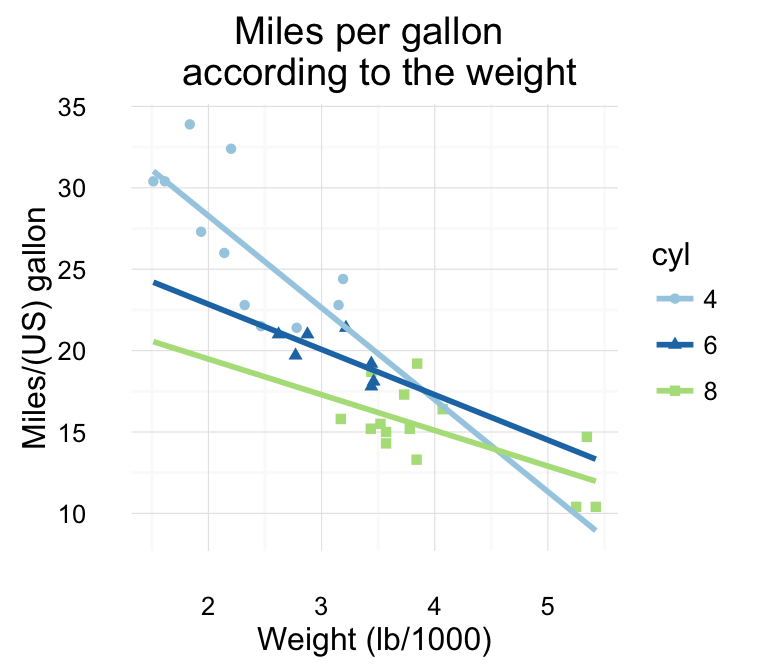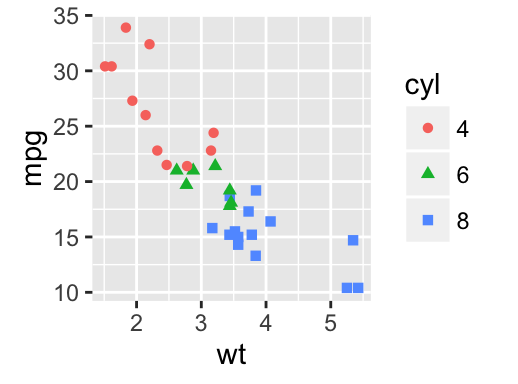

- GGPLOT2 SCATTER PLOT WITH MULTIPLE DATAFRAMES R CODE
- GGPLOT2 SCATTER PLOT WITH MULTIPLE DATAFRAMES R TRIAL
- GGPLOT2 SCATTER PLOT WITH MULTIPLE DATAFRAMES R SERIES
For example, to create a scatter plot, type: This is sufficient to define a ggplot object, but it does not produce any plotted output until at least one layer is added that specifies a geometry ( geom). A standard call to define the base layer of a ggplot is: More specifically, the ggplot() function has two optional arguments: (i) data (an input data frame), and (ii) aes, which defines the “x” and “y” variables in addition to any other variables to be associated with specific aesthetics, such as color, point shape, or line type. The ggplot() function defines the base layer of a ggplot, indicating the name of the input data frame and establishing the association between a certain subset of its variables and their corresponding roles in the graph. A ggplot object is composed of one or more layers, where each layer contains a different graphical object, or grob for short. Two concepts at the core of ggplot2 are essential for its flexibility and efficiency: layers and aesthetic mappings.
GGPLOT2 SCATTER PLOT WITH MULTIPLE DATAFRAMES R SERIES
A useful companion is the online help pages for ggplot2 ( ), which contains a series of illustrative examples under each help page.
GGPLOT2 SCATTER PLOT WITH MULTIPLE DATAFRAMES R CODE
Some topics cannot be fully illustrated in the text due to space constraints, so the annotated code will be supplied in the supplemental materials for you to try on your own. The R code and data sets to reproduce all plots shown in this article can be downloaded online (see Supplementary Material online). It helps if the reader is familiar with base and lattice graphics in R, but it is not a prerequisite. R version 2.15.3 and ggplot2 version 0.9.3.1 were used to create all the plots in this article. Click on the link to “ Getting started with qplot.” The chapter in the ggplot2 book 1 corresponding to qplot() is available on the book's web page.

For more complex graphics, you should use ggplot(), which is the function used for all of the examples in this article. Its original purpose was to provide a transition from R base graphics to ggplot2 graphics. The former is shorthand for “quick plot” and is particularly useful when you want to create relatively simple graphs.

In ggplot2, two functions can be used to create a graphic: qplot() and ggplot(). The creation of a ggplot involves a stepwise process that takes the defined component pieces, called layers, and coordinates them through a sequence of transformations to produce the final graph. In this example, I’m going to look at some mocked-up survey data, with six questions stored in variables Q1 through Q6.Positional adjustments, such as point jittering to reduce overplotting of points or various ways to maneuver bar segments associated with different groups in a bar chart. The best structure for your data depends on what you’re trying to do with it, and in this situation, even if your data is in the right form for analysis, it may not be right for some of the plots you want to make.įortunately, restructuring your data into the right form is straightforward using the tidyr package and the pivot_longer() function. Likewise, if you want to split a plot into panels (or facets, in ggplot2-speak), you must plot a single response variable, with a grouping variable to indicate which panel the data should be plotted in. As a bonus, it will probably be easier to analyse your data in that form too. The usual answer in this scenario is that you should restructure your data before plotting it. For example, in situations where you want to plot two columns on a graph as points with different colours, the two columns often really represent the same variable, and there is a hidden grouping factor which distinguishes the data points you want to colour differently.

Ggplot2 doesn’t provide an easy facility to plot multiple variables at once because this is usually a sign that your data is not “tidy”. Pivoting longer: turning your variables into rows Here is a way to achieve to plot them efficiently using R and ggplot2.
GGPLOT2 SCATTER PLOT WITH MULTIPLE DATAFRAMES R TRIAL
For example, a randomised trial may look at several outcomes, or a survey may have a large number of questions. In exploratory data analysis, it’s common to want to make similar plots of a number of variables at once.


 0 kommentar(er)
0 kommentar(er)
